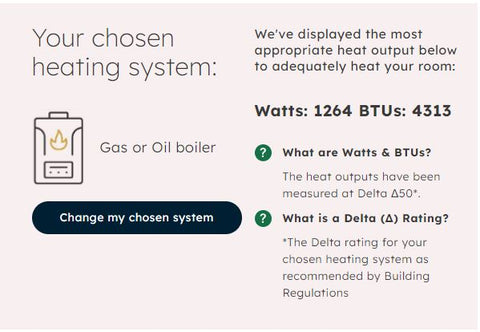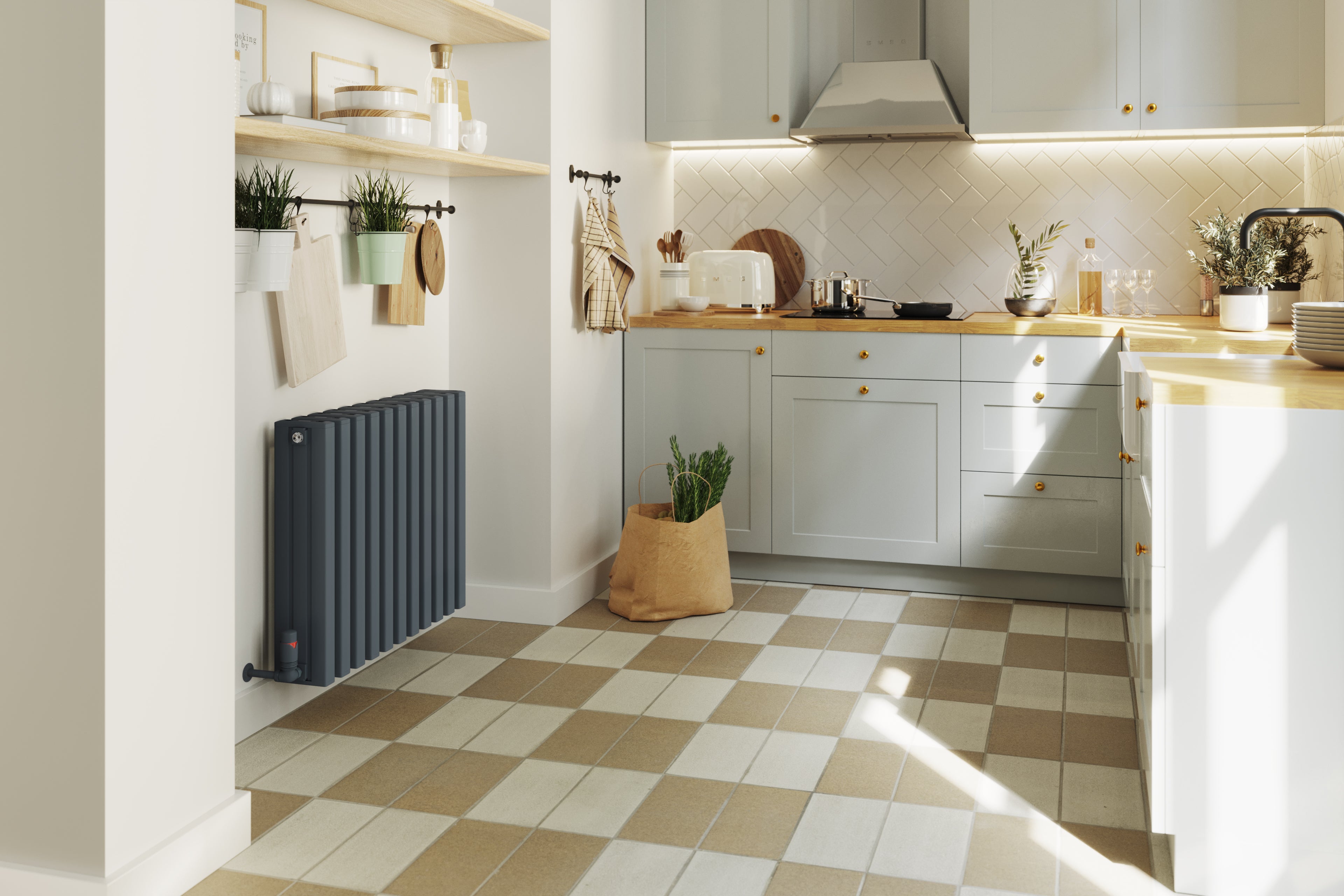
Radiator Impact on System Sizing and Configuration Efficiency
Radiator Data
We cannot stress this enough - if you only see a heat output without a Delta Value, you should never purchase that radiator. Let’s look at what a good radiator listing for heat output looks like. This is for our Alpha - White Column Radiator H600mm x W592mm 2 Column
- Δ30: 313 / Δ40: 449 / Δ50: 595
Industry History
In 2005, condensing boilers became mandatory, they can be up to 94% efficient compared to non-condensing older boilers which can be around 60% efficient. The census data from 2011 tells us that only 6 years after they became mandatory, almost half of the UK gas boilers were condensing boilers (Delta 40), It is now 2023 at the time of writing, so you can imagine what the landscape looks like now. The Census data for this will be released later this year so can be confirmed.Why is this a problem?
A lot of websites out there show you Delta 50 heat outputs, as this is the industry standard. Some don’t show the heat output Delta at all and it is clear that these heat outputs are often Delta 70 (boiler water level), which is totally unrealistic. If you have a Delta 40 system, and you purchase a radiator based on the Delta 50 heat output, this means that in order to get the Delta 50 heat output on a Delta 40 system, you have to turn up the boiler temperature, which in turn for say a condensing boiler means that your boiler will no longer condense, which is where the efficiency and energy saving comes from. Doing this will lower the boiler efficiency to that of a non-condensing boiler and increase your running costs significantly.
What is the UK Law?
Delta 30 and delta 50 must be shown on all products, however, we show Delta 40 as well because while it shows a lower heat output on a radiator compared to Delta 50, it might match the system you have in place given the census data available. So, in order for you to be able to purchase a radiator that will heat your room and have an efficient system that doesn’t cost the earth to run, the Delta 40 is a very helpful piece of information for Gas installed boilers, heat pumps would need to use Delta 30 or lower to avoid staggering costs.
An example of great functionality
Now if we look at the top part of the product page on our website, I entered my system below, which then highlights the heat output I can expect (Delta 50):
 I can click on “Change my chosen system”, which will then update all radiator listings on the website to highlight the heat output I can expect for my new choice:
I can click on “Change my chosen system”, which will then update all radiator listings on the website to highlight the heat output I can expect for my new choice:

I then chose Low-temperature system e.g. heat pump for my example, which now highlights the new system expected heat output to me for this radiator (Delta 30):

In very simple terms
The heat output of the radiator is going to be defined by the system in place and the flow temperature, not whatever a website deems as the “industry standard”. Any website that does not show this data clearly is misleading the heat output you will actually get when the radiators are installed on your system with your boiler flow temperature. So rule 1 – When choosing a radiator, the first thing I need to know is my heating system and what Delta heat output that relates to.
Room Data and BTU Calculators
In order to know what size radiator you need, the height/width may be a requirement for your home i.e. can it physically fit. But, is not the radiator size that is most important when fitting to a specific system. When we talk about the size of a radiator, we mean the heat output of the Delta and if it is enough to heat our space. Calculating a room energy requirement is what we need to do, this tells us that when it is a certain temperature outside and we want the room to be a certain temperature, we need this much energy (or heat) from the radiator. These are commonly called BTU calculators and we can confidently say that we have built the only one that works. We call it RADSIZER®, which you can try here:
Here is how to identify a bad BTU Calculator quite easily:
- It doesn’t ask you what system you have
- It doesn’t ask you your rough geographical location
- It only asks you for the length and width of a room
- It doesn’t ask you about each wall individually
- It doesn’t ask you how many radiators you have in the room
- It doesn’t ask you where your main thermostat for the heating control is
- It only asks a handful of questions
- It takes less than 5 minutes to complete
That would be the bare minimum for a reasonable estimate. Here are some examples as to why these questions are important: Geographical location – The calculations and algorithms required to work this out rely on the second law of thermodynamics principles, specifically the statements around temperature gradients and what is in the way, like a wall construction or windows. You need a radiator that has a heat output allowing your system to work at its efficient rate for the vast majority of the year, only increasing the boiler temperature for those rare days that are extremely cold. You may find some statements online about how “the average UK winter temperature is 5°C, so this doesn’t matter”, however, it's not 5°C early morning or late evening when we generally rely on heating. The heat loss of your home will not acknowledge this floating average because physics won't simply change how it works just because we want it to, so we can sell a radiator. So if you live in Brighton, you could calculate your heat loss based on a winter design temperature or external temperature of -1°C. However, if you live in Scotland, using that design temperature is a good way to result in raising your boiler temperature and reducing your wallet size. Room Orientation – Asking only for the length and width of the room will result in proving a somewhat useful heat output requirement if you have a perfectly square room that has 4 external walls. But if this isn't your room, then the result will again, leave you dissatisfied with your new radiator. If you follow industry experts, BSI (British Standards Documentation) which is basically compiled by the likes of CIBSE and BRE (the engineering experts for pretty much all property-related concepts), then you know there are a lot more important factors that need to be considered than these simple questions. I may be tooting my own horn, as both the author of this blog and the designer of the smart algorithms, but in order to create my smart algorithm that adjusts questions and results based on property nuances that you enter, I spent about 6 months researching, designing the core algorithm and paper testing the algorithm, which was followed by development and system testing. So before we even started the development of RADSIZER® for the website, there was a lot of work put into the algorithm design. If we could have done it by asking a few simple questions then we would have, but all that results in is the consumer, you, not getting anything useful. The proof is in the pudding as they say, so you are welcome to try our RADSIZER® and compare the results to other BTU calculators online and draw your own conclusions.
Radiator Material Choice
We cover this fully in a separate blog where we look at the impact of radiator material on heating system efficiency. But if you have been following along and had a look at the RADSIZER® compared to other BTU calculators online, you can see the effort we put into our statements vs other websites. In a nutshell, what this boils down to is, because of the functionality of different materials, the amount of wasted energy varies on different radiators. The industry and online advice generally claims that it doesn’t matter, or even that a certain material is better because of a specific factor, but when you take the time to actually work it out as we have in the blog above, what you find is that the following applies:
- Given that any stored energy in the radiator is only released after the heating system is turned off
- The amount of material (dry mass/kg weight of the radiator) and the water content directly impacts the amount of energy that is required to allow the radiator to deliver the heat output advertised. And that energy is wasted when the heating system is turned off.
Let's imagine we have two radiators, both achieving the required heat output. Radiator A has less water content and material mass than Radiator B. During the heating period they will use the same amount of energy but after the heating period, the one with the higher water content and material mass (Radiator B) will waste more energy. The amount of energy that is wasted directly relates to how hot you had to heat the water to begin with. However, the biggest impact is that the more water and mass that you have to heat up to will directly relate to how long it takes for your room and the home as a whole to heat up. When this is slow, this often results in you raising your boiler temperature which reduces the energy efficiency of the boiler and costs you more to run. Jumping back to our original question - radiator impact on heating system configuration and efficiency, lets summarise.
Summary
While the heating system efficiency is generally dictated by the water flow temperature, there are 3 significant points when choosing a radiator that should be considered and done effectively in order for you to run your system efficiently:
- In order to run the system at a certain temperature, you must purchase the radiator based on the correct Delta heat output, this Delta heat output reflects how much heat you get on a given system and flow temperature.
- To identify the radiator size you need, you must calculate the room heat loss whilst considering the system and radiators that will be put in place, a suitable tool (much like our RADSIZER®) is required to achieve this.
- The dry mass and water content of a radiator will directly relate to how much energy is wasted at the end of the heating period, even where you only use a lower setback temperature like a heat pump. This is because even though all energy stored in the radiator will become heat energy, it does not all become heat energy when it is useful. So when comparing radiators of the same heat output, looking at water content and dry mass can give a further indication of energy wasted and therefore running cost.
We hope that this article has been helpful on your journey of purchasing the perfect radiator for your room. We urge you to try RADSIZER®, it's totally free - apart from the cost of your time, but you won't regret it when your home is lovely and warm even on the coldest winter days. Once RADSIZER® has calculated your room heat requirement, it will suggest some suitable radiators for your needs. Or you can take the value and browse our wide range of bathroom, designer, column and central heating radiators to find your perfect match.










